Vietnamese educators deliberate cautious approach to AI in schools
The Principal of M.V. Lomonosov Secondary and High School in Nam Tu Liem, Hanoi, Mr. Nguyen Quang Tung, acknowledges the successful integration of artificial intelligence (AI) in specialized school clubs such as Science, Information Technology, Robotics, and STEAM. Teachers have adopted AI to enhance their teaching methodology, scientific research, and even in crafting innovative experiences and delivering speeches at school events.
However, beyond these clubs which operate under the school programs approved by principals, there is a pressing need for a district or provincial-level assessment by experts. Tailored experimentation and lessons derived therefrom should guide the widespread implementation of AI in education.
Mr. Tung highlights the evolving nature of AI technology, insisting on adaptable teaching plans and a well-devised strategy for training educators. Abrupt decisions to deploy AI after a short training period risk poor outcomes and the potential need to recruit external companies for instruction.
An independent education expert, Dr. Vu Thu Huong, formerly of Hanoi National University of Education’s Primary Education Department, emphasizes the individual psychological requirements of students in the classroom. She stresses that AI can at best offer supplementary assistance and warns against over-reliance possibly leading to unpredictable consequences.
Dr. Huong advocates for a holistic approach to education that combines traditional and modern methods, allowing students to experience and engage in actively acquiring knowledge and skills from diverse perspectives.
Echoing Dr. Huong, Vice President of Hanoi National University of Education, Associate Prof. Dr. Tran Thanh Nam, spotlights the prioritization of AI literacy and data analytics skills in the workforce by 2027. Early education in AI is vital for students, yet the timing, content, and manner of its integration demand thorough research.
Earmarking the core capabilities students must acquire, such as information discernment, effective knowledge-seeking, evaluating reliability, organizing, and presenting information compellingly and ethically, must precede the consideration of AI as a tool.
Associate Prof. Dr. Nam advises a cautious and meticulously tested approach to equip students with AI skills, ensuring a safe and effective learning environment that fosters comprehensive personal development before broad-scale rollout.
The topic of integrating AI into education, particularly in Vietnam, is an increasingly important discussion due to the rise of technology use in the classroom and the future job market demands. It’s clear from the article that Vietnamese experts are advocating for a balanced and cautious approach. Below are additional relevant facts, key questions, challenges, controversies, and advantages, and disadvantages of AI in education.
Additional Relevant Facts:
- Vietnam has been experiencing rapid advancements in technology and is looking to integrate AI in various sectors, including education, to remain competitive globally.
- The government of Vietnam has expressed a desire to improve the national education system’s quality through technological innovation as part of its socio-economic development plans.
- The COVID-19 pandemic has accelerated the use of digital technologies for remote learning, which could facilitate the implementation of AI educational tools.
Key Questions & Answers:
Q: Why is a cautious approach to AI integration in Vietnamese education important?
A: A cautious approach ensures the reliability and effectiveness of AI tools, addresses individual student needs, and manages potential negative impacts on both the educational system and societal norms.
Q: What are the core capabilities that educators believe students must acquire before considering AI as a tool?
A: Core capabilities include critical thinking, information discernment, effective knowledge-seeking, evaluating reliability, organizing, and presenting information ethically and compellingly.
Key Challenges & Controversies:
– One challenge is bridging the digital divide to ensure all students can benefit from AI, irrespective of their socio-economic background.
– Concerns exist regarding data privacy and security for students, especially when using AI tools that collect and analyze student data.
– There is the challenge of adapting AI technologies to cater to diverse learning styles and requirements.
– A controversial topic is the potential for AI to replace human teachers, causing job losses and depersonalizing education.
Advantages:
– AI can offer personalized learning experiences, adapting to each student’s strengths and weaknesses.
– It can automate administrative tasks, allowing teachers more time to focus on teaching and student interaction.
– AI has the potential to provide instant feedback to students, enhancing the learning process.
Disadvantages:
– Overdependence on AI could reduce critical thinking and problem-solving skills if students rely too strongly on technology for answers.
– There are significant costs associated with implementing and maintaining AI systems in schools.
– The risk of widening educational disparities if only well-funded schools can afford to integrate AI technology.
In terms of valuable resources, readers interested in the broader topic of AI in education may want to explore the following websites:
– United Nations Educational, Scientific and Cultural Organization (UNESCO)
– Organisation for Economic Co-operation and Development (OECD)
These links lead to organizations involved in education and technology worldwide, providing reports and guidelines that can help frame the conversation on AI in education and how countries like Vietnam can approach the integration of such technologies.

